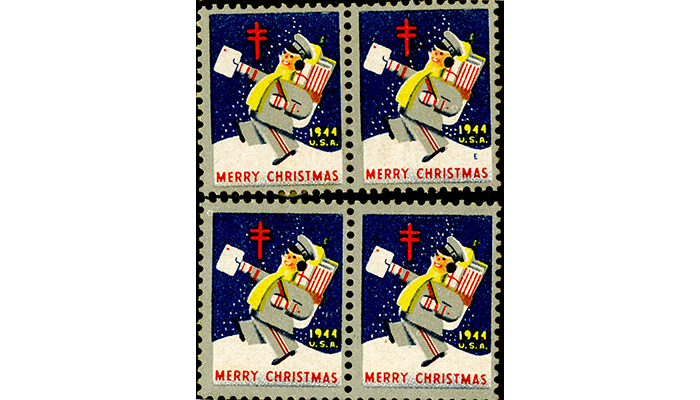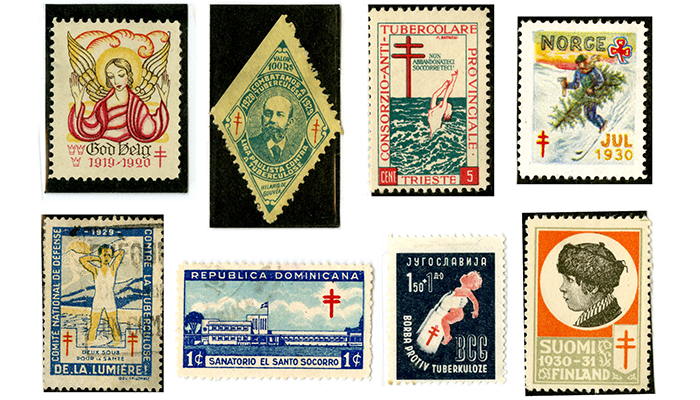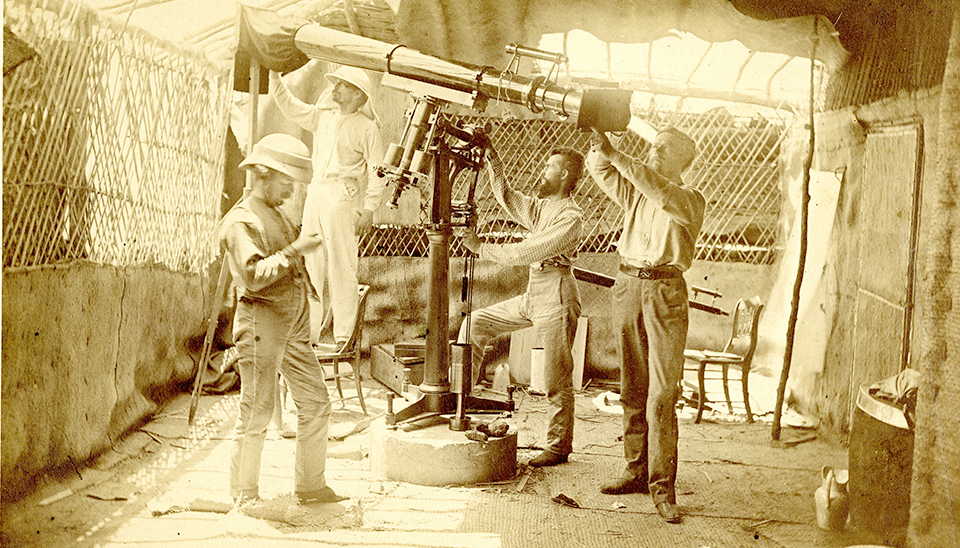Until late in the 20th century, communicable diseases like tuberculosis ravaged communities, families, and the warfighter. Treatments were often ineffective, out of reach for many, and not publicly supported. The story of how a simple postage stamp campaign supported the fight against infectious disease in both civilian and military environments is told through the Christmas seals in our Philately Collection from the Otis Historical Archives (OHA 273).
Mycobacterium tuberculosis is among the most deadly and contagious bacterium. It afflicted millions during the nineteenth and mid-twentieth centuries. Identified by Robert Koch in the 1880s, tuberculosis was known as the "white plague" – named in contrast to the bubonic plague or "black death" – and colloquially as "consumption."
Throughout much of the 1800s, patients sought refuge from crowded environments, especially in rapidly growing urban areas where transmission among infected individuals was high. One popular treatment option was known as the American sanatorium movement, pioneered by Dr. Edward L. Trudeau in New York's Adirondack Mountains. Patients were prescribed a regime of a healthy diet and increased exposure to the outdoors. These treatments and segregation helped some recover, but the sanatorium movement, in America and abroad, depended principally on private support and could not serve as a viable model until a more permanent source of funding appeared.
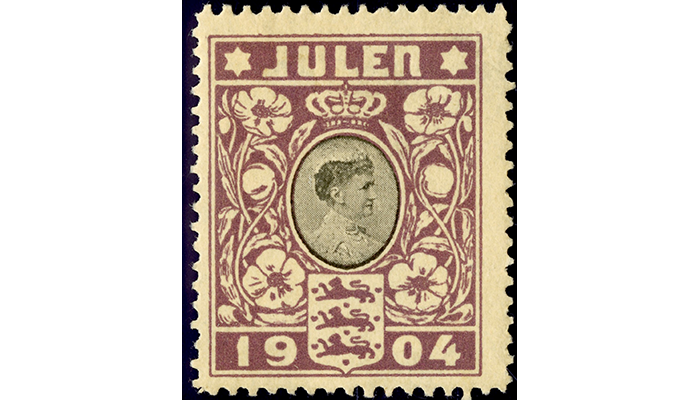
The first Christmas seal was produced in Denmark in 1904 by Einar Holboell. The seal bears the likeness of Queen Louise of Hesse-Kassel, of Denmark, and the word Julen, Danish for Christmas. (NMHM, OHA273 Philately)
In 1903, Copenhagen postal clerk Einar Holboell imagined a new way of raising money for his local sanatorium through a regular function of the state: the sale of postage stamps to mail letters and packages. Holboell envisioned that the selling of an additional stamp to raise funds for diseases like tuberculosis would be fruitful. He realized the advantages of generosity during the holidays, meager mailing costs, and the widespread use of post offices could generate significant money for his cause.
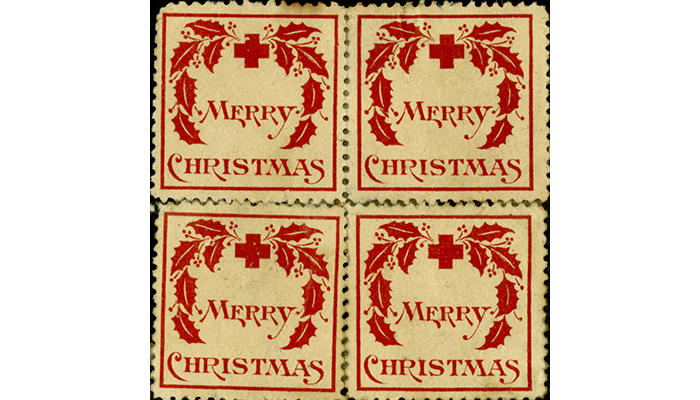
The first Christmas seal produced in the U.S. was designed by Red Cross volunteer Emily Bissell in 1907. The Red Cross symbol remained in Christmas seals until 1920 when the partnership with American Red Cross for distribution ceased. (WX1)
The idea spread and, in 1907, was adopted in the U.S. In Delaware, Red Cross volunteer Emily Bissell, working to combat tuberculosis, sought funds to keep her local Brandywine sanatorium open. Bissell designed a stamp and sold it at one cent apiece. With support from the press and associates, she raised over three thousand dollars and continued operation of the sanatorium.

U.S. Stamp #1821 was issued May 31, 1980 and honors Emily Bissell showing her likeness. Here, you can see the use of the emblem of the Lorraine Cross as the sole icon representing the National Tuberculosis Association and its successor organization, the American Lung Association, which continued distribution of Christmas seals after the American Red Cross. (Scott#1823)
The impact of the seals on public health did not go unnoticed with death rates from tuberculosis in the U.S. dropping from approximately 162 per 100,000 to 40 per 100,000 individuals between 1908 and 1945. Abroad, the annual sale of Christmas seals helped to combat the transmission of tuberculosis for American troops during World War I and World War II. The Christmas seal became a symbol of U.S. dedication to public health.
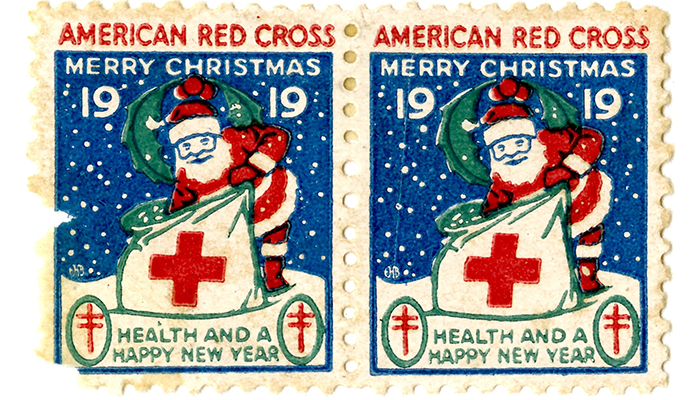
Collected and preserved at the museum as a part of our medical Philately Collection, the Christmas seals showcase the artistry of designers and reflect the values and novelty needed to fight tuberculosis. Today, modern treatments generate sustainable antibiotics and vaccines for tuberculosis and other lung diseases. However, tuberculosis continues to affect millions of people. According to the World Health Organization tuberculosis kills 5,000 people every day and is more likely to affect those living with HIV/AIDS. Therapies are further complicated by multidrug-resistant tuberculosis (MDR-TB), in which the bacteria is resistant to the two most powerful drug regimens.
The Christmas seal initiative remains today as part of broader efforts by the American Lung Association to focus on improving lung health and preventing lung disease through research, education, and advocacy. Similarly, the Military Health System, specifically the Armed Forces Health Surveillance Branch, continues to survey tuberculosis trends in service members abroad to support medical readiness.
Resources
Barberis, Ilaria, Bragazzi, Nicola L., Galluzzo, L., and Mariano Martini. "The History of Tuberculosis: From the First Historical Records to the Isolation of Koch's Bacillus." Journal of Preventive Medicine and Hygiene 58, no.1 (March 2017): E9-E12.https://www.ncbi.nlm.nih.gov/pmc/articles/PMC5432783/
Centers for Disease Control and Prevention. "Achievements in Public Health, 1900-1999: Control of Infectious Diseases." Morbidity and Mortality Weekly Report. Last modified May 5, 2001.
https://www.cdc.gov/mmwr/preview/mmwrhtml/mm4829a1.htm
United States Public Health Service. Vital Statistics of the United States, 1945, Part I: Natality and Mortality Data for the United States Tabulated by Place of Occurrence with Supplemental Tables for Hawaii, Puerto Rico, the Virgin Islands and Alaska. Washington, D.C.: U.S. Government Printing Office, 1947.
https://www.cdc.gov/nchs/data/vsus/vsus_1945_1.pdf
Relevant Links:
Arago: Philately
https://arago.si.edu/category_2027477.html
The American Lung Association and Christmas Seals
https://postalmuseum.si.edu/americasmailingindustry/American-Lung-Association.html
Visual Culture and Public Health Posters: Tuberculosis
https://www.nlm.nih.gov/exhibition/visualculture/tuberculosis.html
Buy Christmas Seals: Protect Your Home from Tuberculosis
https://collections.nlm.nih.gov/catalog/nlm:nlmuid-101452781-img



